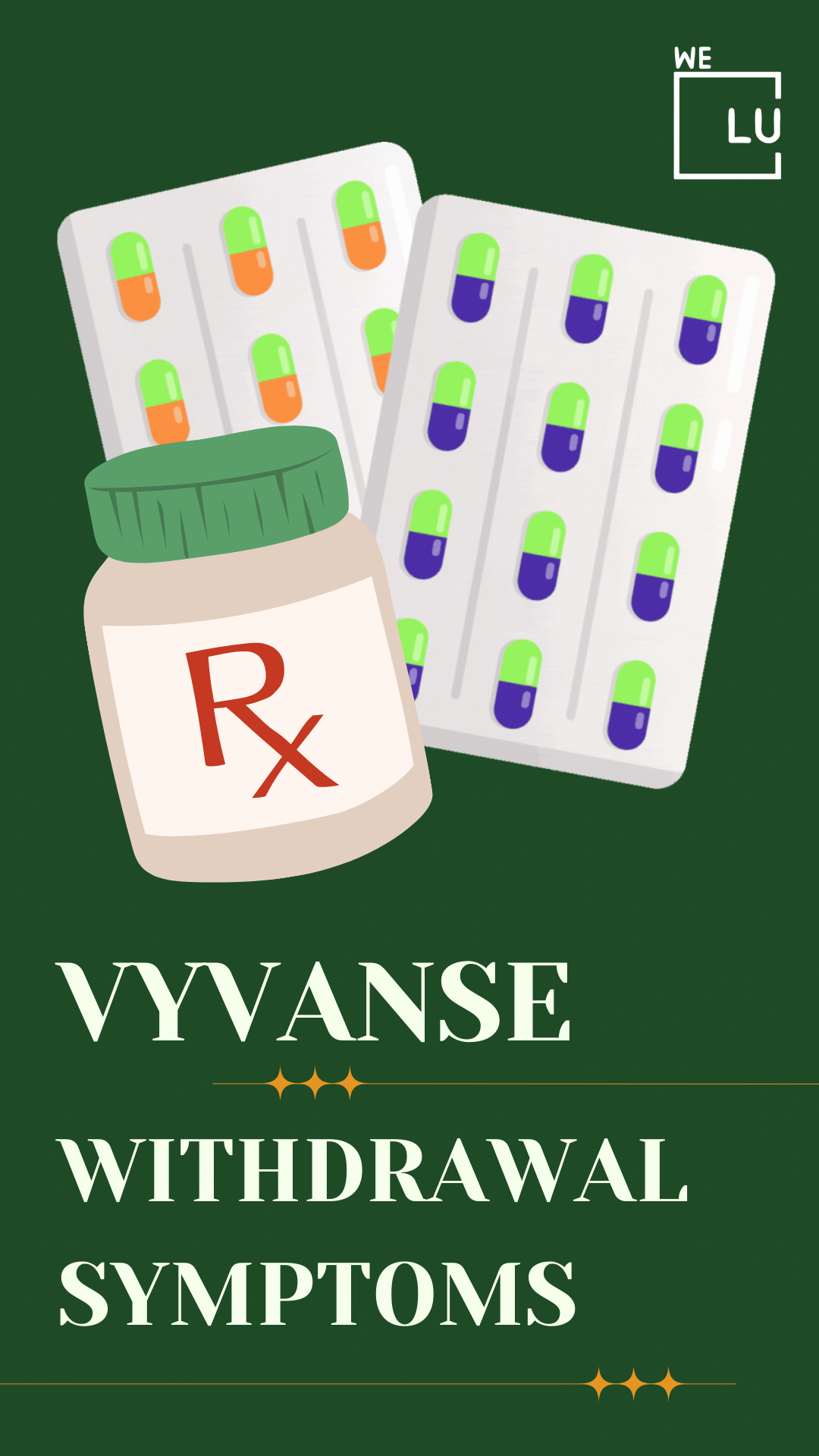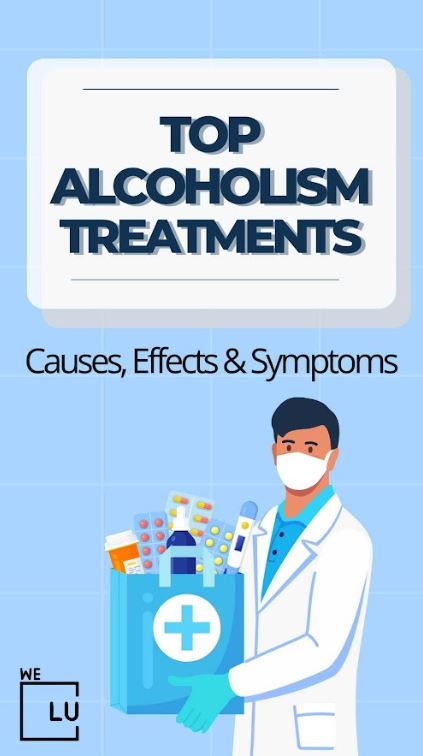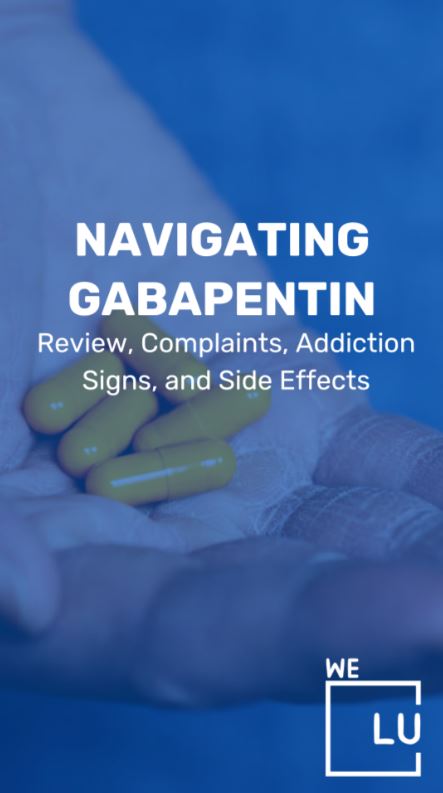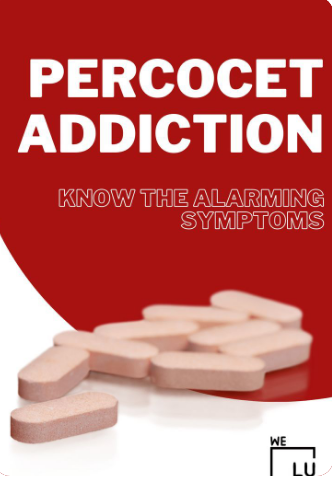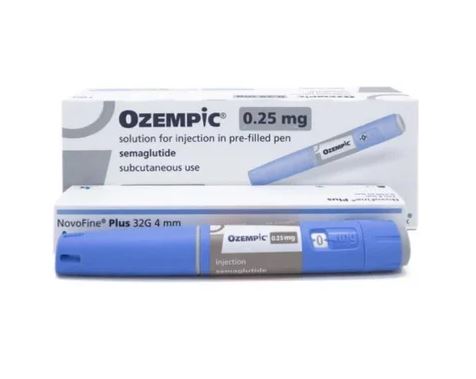What is an Alcoholic Nose?
An alcoholic nose, or drinker’s nose, has been linked to an uncommon condition called Rosacea, worsened by long-term heavy alcohol consumption. An alcoholics nose is a skin disorder recognized by the nose’s reddish, bumpy, inflated appearance and usually red cheeks. Alcohol can affect the appearance of the skin in many ways and contribute to the characteristic redness of an “alcoholic nose.”
While alcoholism likely contributes to and aggravates a red nose alcohol case, it does not seem to cause the condition in the first place. A “red nose alcohol” or ” “purple nose alcohol” condition can also occur in people who do not drink alcohol. Other factors, such as genetics and environmental factors, may also contribute to developing an “alcohol nose.”
Origins of Alcoholics’ Nose
Classic Hollywood cartoons and films featuring actors like W.C. Fields may make light of Alcoholics’ noses. And attribute the condition to drinking. Excessive drinking while already suffering from Rhinophyma, a rare medical condition, can spur the worsening of an alcoholism red nose. That’s why an Alcoholic nose can indicate long-term alcohol dependence.
Alcohol Nose Pictures
The below alcohol nose pictures show the disfiguring red nose from alcohol and other conditions. While Rosacea can be triggered by heavy chronic drinking, it can also be genetic or caused by other factors.
Rosacea and rhinophyma can vary significantly in appearance and severity among individuals. It is vital to speak with a healthcare provider for an accurate diagnosis and appropriate treatment plan if you suffer from an alcoholism nose disorder.
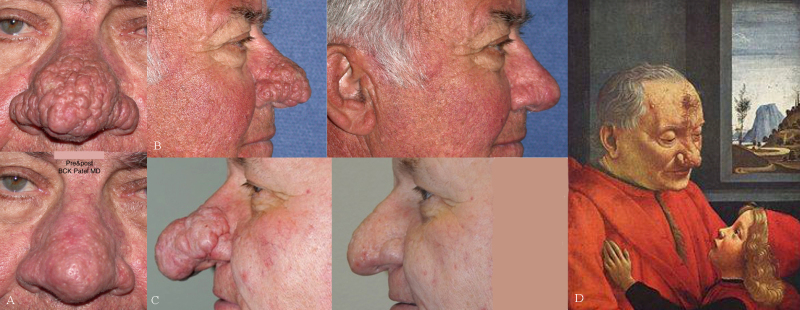
So, what precisely is an “alcoholic nose,” and what provokes it?
Alcoholism Nose Defined
An alcoholic nose, also known as Rhinophyma, has spider veins on the nose, possibly aided by and or worsened by heavy alcohol consumption. It is a skin condition that is part of Rosacea and causes chronic skin inflammation.
It is characterized by redness, swelling, and bumpiness around the nose due to broken blood vessels. Alcoholism can lead to more severe cases where the bulbous tip of the nose may appear purple and become disfigured due to increased blood vessel ruptures.
Gin Blossom Nose
What is a Gin Blossom nose? Gin Blossom nose is a term used to describe a red or swollen nose caused by excessive alcohol consumption over time. The name originates from the idea that heavy gin drinkers tend to develop this type of rosacea. This skin condition causes persistent redness and visible blood vessels on the face.
While gin itself is not necessarily the cause of a gin blossom nose, alcohol can contribute to rosacea’s development.
Not all heavy drinkers will develop a Gin Blossom nose, and not everyone with a red or swollen nose is a heavy drinker. Other factors, such as genetics, sun exposure, and certain medical conditions, can also contribute to the development of rosacea.
Rhinophyma or Red Nose from Alcohol?
Rhinophyma is the medical phrase for “alcoholic nose.” It is a rare condition that typically affects Caucasian males between 50 and 70 and is an advanced stage of rosacea. It’s characterized by the following:
- A thickening and reddening of the skin
- Broken blood vessels
- Pitting and scarring
- A bulbous or disfigurement of the nose
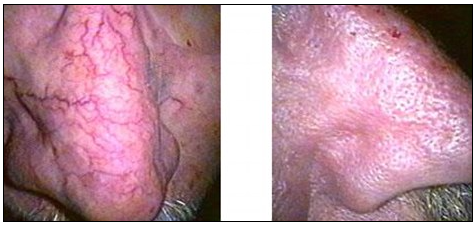
Rhinophyma can be seen via the firming and thickening of the skin, and red, orange, and purple colors mostly noticed on the nose. These red nose signs may occur elsewhere, including the chin, forehead, cheeks, ears, plus eyelids.
Red Alcohol Nose
An alcoholic nose is characterized by an orange to a reddish hue, often with facial flushing, and an enlarged, engorged nose with prominent blood vessels. In addition to these physical signs, excessive consumption of alcohol can cause increased sensitivity to odors and tastes, runny nose or watering eyes, difficulty concentrating, and an impaired sense of smell.
Purple Nose Alcohol Nose Condition
The term “purple nose” is often also used to describe the condition known as rhinophyma, a subtype of rosacea. Here, the appearance may become more of a purple nose alcohol skin condition.
Alcohol can damage your nose. Long-term alcohol exposure can lead to alcoholic rhinopathy. This can cause corrosion of the nasal tissue and increase blood vessels, fluid accumulation, and a red, swollen appearance. It can even contribute to the formation of polyps in the nose.
Signs of Alcoholic Nose
An alcohol nose is a condition caused when alcohol is broken down in the body, producing an unpleasant smell. One sign of an alcohol nose is an unpleasant odor from the nose that smells like alcohol.
Treatment for an alcoholic nose condition includes reducing alcohol consumption, regular exercise, and increasing your intake of fresh fruits and vegetables.
Origins of Alcohol Nose
Research suggests that alcohol-induced rhinopathy is likely caused by a combination of several factors, such as exposure to alcohol steam when consuming liquor, the direct action of alcohol on the nose tissue, and the effects of alcohol on the immune system. Not all individuals who drink alcohol will experience alcoholic rhinopathy, and the severity of symptoms will depend on the quantity and type of alcohol consumed.
Can Alcohol Damage Your Nose?
If you already have rosacea or rhinophyma, drinking can worsen these conditions and affect the nose’s appearance. Alcohol addiction can cause other, more severe problems.
Rosacea is a skin disorder with a sub-disorder called rhinophyma. A side effect of Rosacea. For a long time, it was widely accepted that Rhinophyma was caused by alcohol use disorder. However, new research released in 2015 proved otherwise.
While alcohol can contribute to rosacea and rhinophyma, it does not seem to cause the conditions in the first place.
According to the report, Rhinophyma (the medical name for the alcoholic nose) disease does not correlate with drinking but may be worsened if the condition already exists. [1]
While medical professionals aren’t exactly sure what causes rosacea and rhinophyma, they believe that certain factors may produce the conditions:
- Genes. People who have relatives with rosacea are more likely to have the disease themselves.
- Pale skin that blushes easily. Blood vessels that dilate easily may produce blushing and rosacea.
- Gender and age. Women 30-60 years old or experiencing menopause are more likely to have rosacea. Men aged 50-70 have a greater likelihood of having rhinophyma.
- Ethnic background. Rhinophyma risks are higher for people of Scandinavian, Scottish, English, or Eastern European descent.
Alcoholism Nose Explanations
Alcohol is an irritating substance that causes inflammation in the skin, leading to redness, bumps, and swelling around the nose. Alcohol also decreases blood flow to the affected area, making it more difficult for skin cells to heal, further exacerbating this visual effect. Long-term alcohol use can even lead to permanent facial changes such as thicker/larger pores and visible veins near the nose due to broken capillaries.
Skip To
Learn More:
- Skin Before and After Quitting Alcohol
- Alcoholism Treatment
- Comfortable Alcohol Detox
- Early Signs of Alcoholism
- Alcohol and Depression
- Drug and Alcohol Tests
- Alcoholic Hepatitis vs Cirrhosis
- Acute Alcohol Intoxication
- Effects of Alcohol Withdrawal
- Alcohol Withdrawal Timeline
Help for Red Nose from Alcohol
If you or a loved one has an Alcoholics nose, getting help as soon as possible is vital. Speak with your doctor about available treatment options, support groups, and counseling to begin the process of recovery. With the right help and guidance, Alcoholics’ nose can be treated and managed so those suffering can lead healthier lives.
Red Nose Alcohol Causes
An alcoholism nose may also be caused by conditions other than alcohol consumption, such as a sinus infection or an allergic reaction to certain foods and drinks. Other alcolism nose symptoms include:
- A dry, sore, itchy, or burning sensation in the nose.
- Discharge from the nose.
- Nasal congestion due to mucus.
Red Nose Alcohol Treatment
There is no known cure for rhinophyma or rosacea, but treatments can help manage the symptoms. Treatments like oral and topical medicines, laser therapy, or surgical interventions such as electrosurgery, cryosurgery, or laser ablation can help.
Other alcoholism nose treatments can include nasal sprays, antihistamines, and decongestants. If the condition is severe, a doctor may recommend a course of antibiotics or steroid medications.
If you have concerns about the appearance or health of your nose, it is critical to speak with a dermatologist for an accurate diagnosis and appropriate treatment plan. They may also recommend lifestyle changes, such as reducing alcohol consumption, to help manage the symptoms of rhinophyma and prevent further progression of the condition.
Get Help. Get Better. Get Your Life Back.
Searching for Accredited Drug & Alcohol Rehab Centers Near You? Or Mental Health Support?
Even if you have failed previously, relapsed, or are in a difficult crisis, we stand ready to support you. Our trusted behavioral health specialists will not give up on you. Call us when you feel ready or want someone to speak to about therapy alternatives to change your life. Even if we cannot assist you, we will lead you wherever you can get support. There is no obligation. Call our hotline today.
FREE Addiction Hotline – Call 24/7Alcohol Nose and Rhinophyma
Historically, the alcoholic nose has been mistakenly linked to alcohol consumption, but no substantiated evidence exists that excessive alcohol use is the cause of rhinophyma. Rather, this false association has become a stigma for individuals with Rhinophyma. Those suffering from this condition are called unflattering sland names like:
- Alcoholic nose
- Gin blossom
- Potato nose
- Drinker’s nose
- Whiskey nose
Alcohol Nose and Alcohol Use Disorder Statistics
There are not many studies dealing with alcoholic rhinopathy; some studies have found that consumption of alcohol is strongly correlated with the growth of upper respiratory tract disorders, including rhinophyma, a type of alcoholic rhinopathy. The National Institutes of Health also reports that alcohol-dependent people are likelier to suffer from nasal obstruction and a diminished sense of smell or taste.
It’s a long-held belief that alcohol abuse causes this skin disease, like the red nose skin condition called rhinophyma. The phrase alcoholic nose is another example of the stigma and misinformation surrounding alcohol use disorder. Many speculations have been made that alcohol could result in a large red nose for some people, specifically that such a trait indicates an addiction. However, this is not entirely true. Not all people with an alcoholic nose or rhinophyma have alcoholism, and not all people with alcoholism will develop an alcoholic nose.
85.6%
85.6% of people ages 18 and older reported drinking alcohol.
Source: NIAAA
95,000
An estimated 95,000 people (approximately 68,000 men and 27,000 women) die from alcohol-related causes annually, making alcohol the third-leading preventable cause of death in the United States.
Source: NIAAA
140,000
Heavy alcohol use was accountable for over 140,000 deaths in the United States annually from 2015 to 2019, or more than 380 deaths per day.
Source: NIAAA
Alcoholic Nose (Rhinophyma) Facts
What is Rhinophyma?
Rhinophyma is a skin condition marked by a large red, bumpy, bulbous nose. It can ensue as part of “phymatous rosacea.” The reason for rhinophyma is not known, but it’s thought of as a subtype of intense rosacea. Rosacea is a typical, chronic inflammatory skin disease. It causes varying redness or flushing of your face, especially in the cheeks and nostril regions. Small, red bumps and blemishes with pus, called abscesses, may occur on the face due to this infection. According to the National Rosacea Society (NRS), over 16 million Americans are impacted by rosacea.
Rhinophyma has been classified as part of subtype three rosacea. It slowly forms over years and is thought to result from inadequately treated or non-treated rosacea. The result is usually a big mass on the descending half of the nose.
Historically, rhinophyma was erroneously linked with alcohol consumption because alcohol and caffeine can cause local vasodilation, worsening symptoms. This alleged relationship with alcohol has generated a lot of stigma and loss of self-esteem in those suffering from the illness, with several discomfiting terms for the disease, such as “whiskey nose” and “rum nose.”
The diagnosis of rhinophyma is clinical and can be identified by the nose’s bulbous shape, skin pitting/scarring, and telangiectasia. [1] The thicker and more sebaceous nasal tip and alae are usually preferentially enlarged, but involvement can spread to the thinner nasal dorsum and sidewalls to a lesser degree.
With progression, the aesthetic subunits of the nose merge and become obliterated. While the underlying frameworks are usually unaffected, patients often suffer from secondary nasal airway obstruction at the external nasal valves.
Symptoms of Rhinophyma
Rhinophyma (alcoholic nose) typically happens in more harsh cases of rosacea. Some subsequent signs can be found in less severe stages of rosacea. Signs include the following:
- Arbitrary facial flushing.
- Red, purple, and orange, marked areas in the center of your face.
- Bumps and pus-filled pimples are often misinterpreted as acne.
- Telangiectasia is the bulging of tiny blood vessels on the nose and cheeks.
- Susceptible pale skin.
- Ocular rosacea, indicated by a burning or gritty sensation in your eyes, usually with conjunctivitis, marked by redness and inflammation of the eye, and blepharitis, an inflammation of the eyelid.
Symptoms can get more destructive as rosacea advances. More symptoms arise with the onset of rhinophyma. For example, the nose’s connective tissue and oil glands may grow. The ensuing changes to your nose may include:
- Incremental growth into a bloated, bulbous form
- Multiple oil glands
- Enlarged skin pores
- Rosy skin tone
- Thickening of the outermost layers of skin
- Waxy, irregular, yellowish appearance

Source of the Alcoholic Nose Pictures: National Center for Biotechnology Information https://www.ncbi.nlm.nih.gov/books/NBK544373/bin/Rhinophyma-Composite__final.jpg
Red Nose Alcohol Street Names
There are several slang terms for alcohol-induced red nose or rosacea, including:
- Gin blossom nose, this term specifically refers to redness and swelling caused by heavy gin consumption.
- Rum nose is a term used to describe redness and swelling caused by heavy rum consumption.
- Whiskey nose refers to redness and swelling caused by heavy whiskey consumption.
- Drinker’s nose a more general term used to describe redness and swelling caused by alcohol abuse.
- Booze nose is another general term for redness and swelling caused by excessive alcohol consumption.
- Wino nose describes redness and swelling caused by heavy wine or other alcohol consumption.
It’s essential to note that these terms are often stigmatizing, and it’s paramount to treat individuals with addiction and related health issues with compassion and sensitivity. It’s also vital to remember that redness or swelling on the nose or face can have other causes, and not all people with red noses or rosacea are substance abusers.

Get Your Life Back
Find Hope & Recovery. Get Safe Comfortable Detox, Addiction Rehab & Mental Health Dual Diagnosis High-Quality Care at the We Level Up Treatment Centers Network.
Hotline (877) 378-4154Can Alcoholism Cause a Red Alcoholic Nose?
It was formerly believed that outsized alcohol use was the reason for Rhinophyma. Hence the negative nicknames like alcoholic nose or drinkers nose. Extensive alcohol drinking can drive vessels to dilate in the face and neck, producing a red flushed skin tone. Because of this, the notion that alcoholism caused rhinophyma was preserved for a long time.
However, an examination by the University of South Florida Morsani College of Medicine in 2015 disproved this theory. Considerable patients in the examination were clinically diagnosed with rhinophyma but did not suffer from alcoholism or even drink regularly.
While this study disproved the theory that alcohol use causes Rhinophyma (alcoholic nose), researchers could not uncover what did cause rhinophyma in their patients. However, evidence suggests that ethnic and genetic predisposition may compel this disfiguring skin illness, as it showed most often in people of English, Scottish, Scandinavian, or Eastern European descent. Despite these points, confident reasons for Rhinophyma remain a secret even today.
Rhinophyma (Alcoholic Nose) and Rosacea Difference
Rhinophyma is the last and most extreme stage of acne rosacea. It displays as thickening skin on or near the nose. If untreated, rhinophyma can create additional medical issues, like respiratory problems making breathing challenging.
Rosacea, an ordinary skin condition, causes flushing discoloration first on the cheeks and nose but can spread to the forehead, chin, neck, chest, and back. The precise reason for Rosacea is unidentified, but physicians believe that genetics and environmental facets probably cause some people to be more susceptible. The symptoms tend to appear in phases and advance at each interval. This advancement can include the following:
- Flushing or blushing easily
- Persistent redness
- Lesions
- Pus-filled bumps or pimples
- Visibly broken blood vessels
- A burning or painful feeling on the skin
- Blotchy or raised patches of skin
- Edema and inflation with the buildup of fluid, commonly on the forehead, upper eyelids, nose, and cheeks
- Dry, scaled, and bumpy skin
- Oily skin
- Thick skin
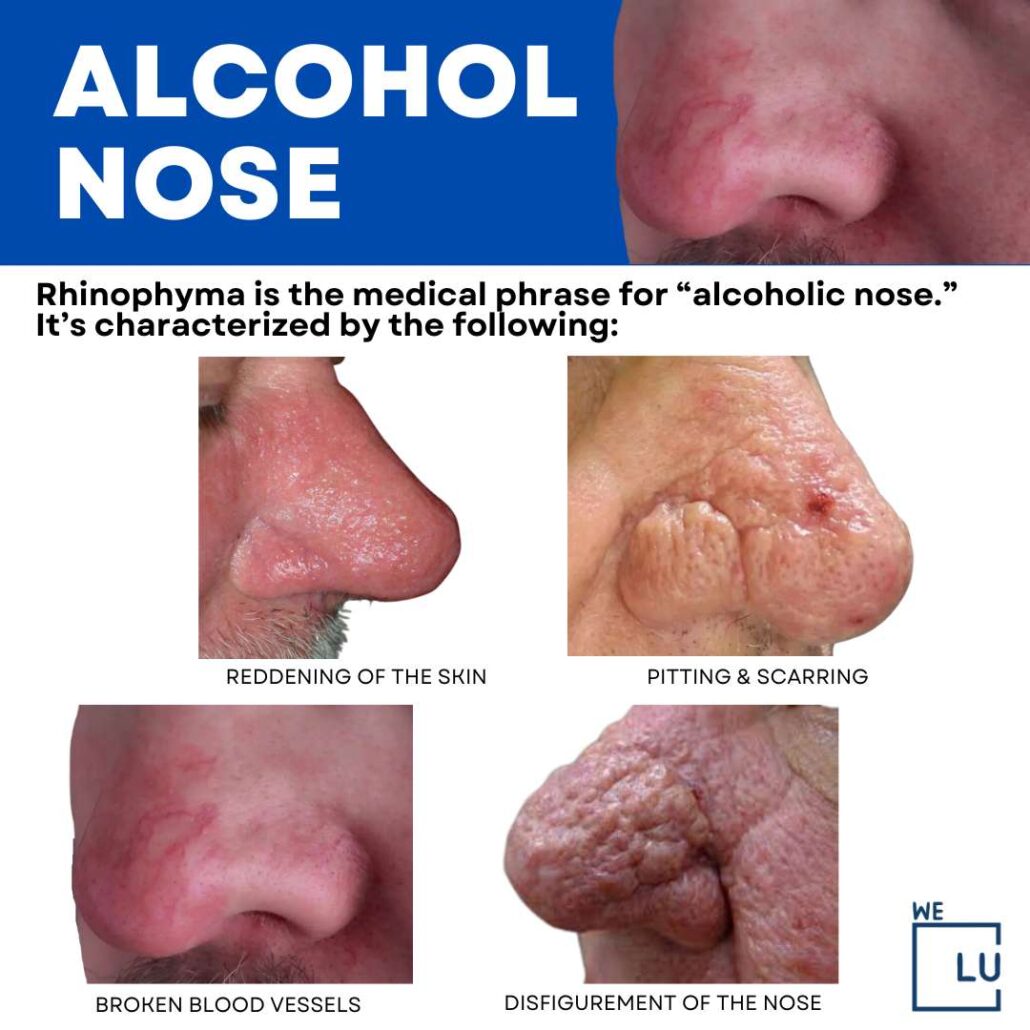
There’s no cure for rosacea, but individuals can prevent flare-ups by understanding what initiates them in the first place. Factors that can cause rosacea symptoms to worsen include the following:
- Drinking alcohol excessively
- Consuming spicy foods
- Consuming hot temperature foods and beverages
- Undergoing stress or anxiety
- Utilizing intense face cleansers
- Exposing the face and skin to harsh weather. Hot and cold temperatures, and powerful winds, can help trigger alcohol nose progression epidodes.
- Partaking in trying physical activities or exercises
- Being in the sun
- Taking hot baths
How Alcohol Affects Rosacea?
Why do alcoholics have red noses? Drinking alcohol can significantly impact those with rosacea, potentially amplifying the redness and irritation associated with this skin condition. In some cases, up to two-thirds of patients suffering from it experience flare-ups when consuming any alcoholic beverage. This occurs because drinking causes blood vessels in the body to open wider than usual – referred to as an ‘alcohol flush’. The widened veins allow more blood flow towards the skin’s surface layer, which increases reddening over areas such as one’s face, shoulders, or chest. By avoiding alcohol altogether, however, individuals living with acute symptoms may be able prevent further aggravation of their existing affliction!
According to a survey of patients suffering from this skin condition, red wine is more likely to trigger flare-ups or worsen rosacea than other drinks. Doctors theorize it’s because of an additional chemical in red wine that also works to enlarge blood vessels, letting far more blood than usual flow to the skin’s surface.
To manage these symptoms of the red nose alcoholic condition, doctors suggest that patients with this condition:
- Bypass red wine.
- Avoid cooking with alcohol.
- Drink water with each alcoholic beverage.
- Comsume alcohol very moderately, if at all.
- Water down alcoholic beverages with seltzer if you must drink.
- Quit consuming all alcohol.
Tips to Prevent Alcoholic Nose
While there is no explicit connection between rhinophyma and alcohol consumption, igesting alcohol brings blood to the skin’s surface, deepening the condition. Thus, the American Academy of Dermatology Association advises that individuals with rosacea construct healthier lifestyles to avert the disease from deteriorating or leading to other complications like difficulty breathing. Most dermatologists suggest people with rosacea:
- Retain a healthy weight.
- Routinely exercise most of the week.
- Quit smoking.
- Restrict alcohol use or refrain entirely.
- Decrease stress.
- Visit a physician regularly to stem rosacea from getting more harmful.
- Plan an appointment with a dermatologist to inform any updates.
- Eat a healthy, balanced diet.
What Alcohol Does to Your Face
The occasional drink typically does not present a health issue. However, frequent and excessive drinking can lead to several problems with the skin. Facial changes can be mild, such as dry skin or flushing. Nevertheless, lengthy alcohol usage can induce other skin problems, like liver disease.
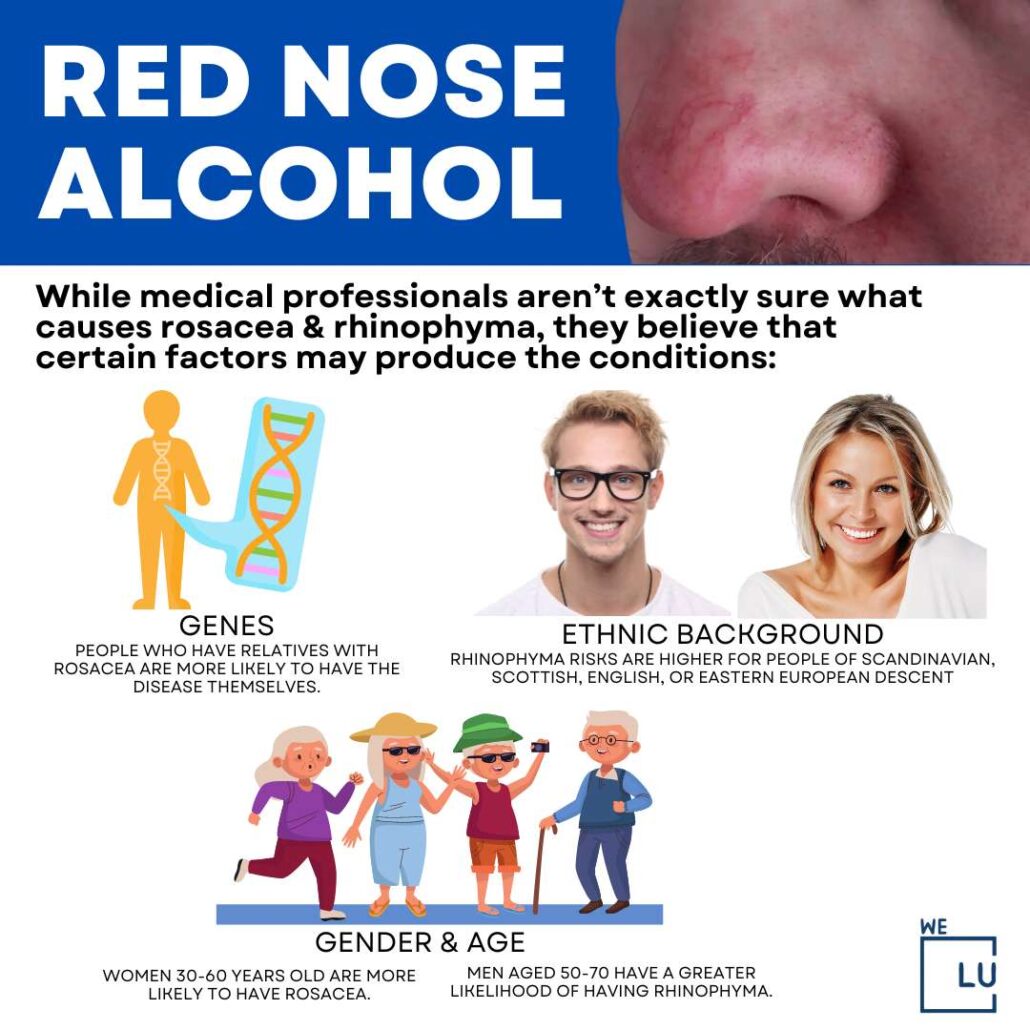
Alcohol can also worsen underlying skin conditions. Among the long-term effects of serious drinking on an individual skin include the following:
- Raised threat of skin disorders: Excessive alcohol consumption can seriously affect the body’s defenses. Those who drink excessively are more vulnerable to bacterial and fungal infections and skin wounds, which could spark further health issues due to a weakened immune system that cannot absorb vital nutrients properly.
- The raised threat of skin cancer: Alcohol lowers our body’s defenses against disease and exaggerates the effects of UV light on the skin. Leading to more severe damage and greater risks. This is an important reminder that alcohol consumption can have a much larger effect than many think regarding skin health [3].
Protracted alcohol abuse can provoke troubles with an individual’s liver, such as hepatitis and cirrhosis. These illnesses can cause considerable shifts in the skin, including:
- Jaundice, a yellowing of the skin.
- Inducing dark skin around the eyes.
- Telangiectasia observable blood vessels on the face, neck, and chest.
- Scratchy skin.
Alcoholic Nose Treatment
Rhinophyma can be treated with medications and surgical intervention. The patient and their physician can determine the best remedy for them.
Medication
Generally, once rhinophyma forms, it doesn’t react well to medicines. Drugs may successfully treat less intense cases and different subtypes of rosacea.
Surgery
Surgery is the standard treatment of severe rhinophyma. Enlarged blood vessels and tissue growth can lead to nose and facial disfigurement. This can be enduring unless the pompous area is surgically exercised. Surgery is the best choice for most patients. It’s thought of as the most effectual alternative for long-term results.
Alcohol Use Disorder Treatment
Although the risks of continuing to abuse alcohol can be serious, many people may feel too ashamed or overwhelmed by society’s judgments to get help. For those dealing with an alcoholic nose and concerned about potentially developing further health problems, healthy lifestyle changes offer a great place to start to prevent their condition from worsening. Seeking treatment programs is another useful step that could make all the difference!
For some individuals with alcohol addiction, enrolling in a treatment program outside their local community can be more effective. This way, they are not inundated with negative social forces and stigma near home. This permits drinking triggers to lapse while improving their chances of clinging to an alcohol sobriety and recovery program.
Treatment plans for alcoholism may include detox, inpatient alcohol rehab, 12-step programs, aftercare and relapse prevention planning, and more. If you or someone you love suffer from alcoholism, contact one of our helpful alcohol treatment specialists today. We can provide information on rehab and detox programs that fit your needs.
The We Level Up NJ alcohol treatment center can supply information on proper rehab and detox programs to fit your demands.

Top 10 Alcoholic Nose Frequently Asked Questions
-
Why do alcoholics have red noses?
Skin redness is associated with drinking a lot of alcohol. Rhinophyma came to be linked with heavy alcohol use. Drinking a lot of alcohol can prompt the cheeks and face of an individual to turn red or flushed.
-
What is the “purple nose alcohol” condition?
Skin redness results from the visible blood under the skin’s surface caused by ruptured blood vessels. In more severe instances, the cheeks and nose may be purple and deform as they become more bulbous.
-
Why does my nose bleed when I drink alcohol?
Alcohol and hot liquids can dilate blood vessels in your nose. Don’t take ibuprofen, naproxen, or medicines that contain aspirin while drinking. These thin the blood and may cause your nose to bleed.
-
Why does my nose get stuffy when I drink alcohol?
Alcohol intolerance can generate quick, discomfiting reactions after you drink. The most typical signs and symptoms are stuffy nose and skin flushing. Alcohol intolerance is provoked by a genetic disorder where the body cannot eliminate alcohol efficiently.
-
Does alcohol make your nose bigger?
Yes. Alcohol use can exacerbate a red nose, also known as rhinophyma, but doesn’t cause it to occur in the first place.
-
Why do alcoholics have a purple nose?
“Purple nose alcoholism” occurs when blood vessels burst. It makes the blood visible under the skin’s surface as it bursts. Leaving the skin purple. In more extreme cases, the nose and cheeks can take on a darker purple hue and become severely disfigured as they become more bulbous.
-
What does a drinkers nose look like?
“Alcoholic nose,” or drinker’s nose, is a skin infection commonly recognized by a red, bumpy, or swollen formation of the nose and cheeks.
-
Why do alcoholics get red noses?
Alcohol is a vasodilator, meaning when someone drinks it, their blood vessels spread open. More blood flows toward the skin, causing the red, ruffled face that’s routine with rhinophyma.
-
Can you reverse rhinophyma or “alcoholic nose”?
You can reverse an alcoholic nose. However, only surgical intervention can change the deformity once the disease progresses to its hypertrophic and bulbous stage.
-
Is “alcoholic nose” really from drinking?
No. It is only a slang term. “Drinker’s nose” is a term used to describe rhinophyma, a skin disorder that affects the nose. It happens even to those who do not drink alcohol.
What is an Alcoholic Nose? Video
Have you ever wondered about the mysterious connection between alcohol and the red, swollen nose phenomenon? 🤔 In this insightful article, we dive deep into the world of the “Alcoholic Nose,” exploring its origins, defining characteristics, and dispelling common myths.
Search We Level Up NJ Alcoholic Nose Treatment & Mental Health Topics & Resources
Sources
- Dick MK, Patel BC. Rhinophyma. [Updated 2022 Oct 1]. In: StatPearls [Internet]. Treasure Island (FL): StatPearls Publishing; 2022 Jan-. Available from: https://www.ncbi.nlm.nih.gov/books/NBK544373/
- Alcohol Facts and Statistics – NIAAA/National Institute on Alcohol Abuse and Alcoholism
- Nehring SM, Freeman AM. Alcohol Use Disorder. [Updated 2022 Jul 31]. In: StatPearls [Internet]. Treasure Island (FL): StatPearls Publishing; 2022 Jan-. Available from: https://www.ncbi.nlm.nih.gov/books/NBK436003/
- Kranzler HR, Soyka M. Diagnosis and Pharmacotherapy of Alcohol Use Disorder: A Review. JAMA. 2018 Aug 28;320(8):815-824. DOI: 10.1001/jama.2018.11406. PMID: 30167705; PMCID: PMC7391072.
- Rehm J. The risks associated with alcohol use and alcoholism. Alcohol Res Health. 2011;34(2):135-43. PMID: 22330211; PMCID: PMC3307043.
- LaHood AJ, Kok SJ. Ethanol Toxicity. [Updated 2022 Mar 18]. In: StatPearls [Internet]. Treasure Island (FL): StatPearls Publishing; 2022 Jan-. Available from: https://www.ncbi.nlm.nih.gov/books/NBK557381/
- Jung YC, Namkoong K. Alcohol: intoxication and poisoning – diagnosis and treatment. Handb Clin Neurol. 2014;125:115-21. DOI: 10.1016/B978-0-444-62619-6.00007-0. PMID: 25307571.
- Newman RK, Stobart Gallagher MA, Gomez AE. Alcohol Withdrawal. [Updated 2022 Aug 29]. In: StatPearls [Internet]. Treasure Island (FL): StatPearls Publishing; 2022 Jan-. Available from: https://www.ncbi.nlm.nih.gov/books/NBK441882/
- Huebner RB, Kantor LW. Advances in alcoholism treatment. Alcohol Res Health. 2011;33(4):295-9. PMID: 23580014; PMCID: PMC3860532.
- Witkiewitz K, Litten RZ, Leggio L. Advances in the science and treatment of alcohol use disorder. Sci Adv. 2019 Sep 25;5(9):eaax4043. DOI: 10.1126/sciadv.aax4043. PMID: 31579824; PMCID: PMC6760932.
